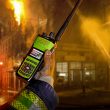Stevens: Interoperability funding tied to 700 MHz
First responders’ ability to communicate interoperably in the future may depend largely on the outcome of a 700 MHz bill scheduled to be considered next week, Senate Commerce Committee Chairman. Ted Stevens (R-Alaska) said today.
By clearing television broadcasters from the 700 MHz band to complete the transition to digital television (DTV), public-safety agencies would receive 24 MHz of much-needed spectrum that is expected to be used to help address capacity and interoperability issues. In addition, funds raised from the auction of other frequencies in the band to commercial operators could be earmarked for public-safety communications, Stevens said during a committee hearing on interoperability of public-safety communications.
Stevens said the committee would consider a DTV bill next week. During the summer, the general consensus on Capitol Hill has been that the broadcasters would have to clear the spectrum by Jan. 1, 2009, but communications problems related to the Hurricane Katrina recovery effort have created “enormous demand” that the airwaves be made available to public safety within the next two years, Stevens said.
But congressional budget estimates indicate an auction in 2009 or later would generate “four to five times” more revenue for the U.S. Treasury than an auction in the near term, Stevens said.
“I don’t know yet what the answer will be, but we have been required by the budget resolution to raise $4.8 billion by action of this committee, and the only possible way to do that will be by passing the spectrum bill,” Stevens said. “We hope that will be part of the reconciliation process and that will become law. If it is not, there will be no funds for interoperability in the coming years.”
And funding for interoperability is needed, as some estimates indicate more than $15 billion will be needed to establish a communications system that would ensure that public-safety personnel from different jurisdictions can talk with each other in times of crisis. Sen. Barbara Boxer (D-Calif.) said the lack of interoperability in the aftermath of Katrina should not be repeated in the future.
“The time to find a solution is now; in fact, it was yesterday or the day before yesterday, and we still haven’t done it,” Boxer said. “We didn’t learn our lesson after the ‘93 World Trade Center bombing; we didn’t learn it after Sept. 11; the wildfires raging in California two years ago didn’t teach us … and Hurricane Katrina showed us. Enough is enough.”
Willis Carter, first vice president of the Association of Public-Safety Communications Officials (APCO), said help is needed on the interoperability front but there are no simple answers.
“This is no time to throw money at ill-conceived, band-aid solutions,” Carter said. “We also caution that solutions should not be thrust upon state and local governments without consideration of cost.”
Indeed, the primary problem after Hurricane Katrina was that the networks established to support first responders were disabled because of damage from the storm, power outages or flooding of network equipment. In such a scenario, even the best interoperability plan is of little use, said David Boyd, director of SAFECOM program office within the Department of Homeland Security.
“Interoperability requires, before all else, simple operability,” Boyd said. “As Hurricane Katrina demonstrated, in the absence of a reliable network across which responders within an agency can communicate, interoperability is irrelevant and impossible.”
Dereck Orr, public-safety communications program manager for the National Institute of Standards and Technology (NIST), said one technological problem in realizing interoperability is a lack of standards. The Project 25 standards process was supposed to alleviate this problem, but only one of the eight standards—one addressing common air interface—has been finalized, and tests indicate that none of the radios available today meet all aspects of that even that standard.
The Senate committee will conduct another interoperability hearing with public-safety communications this afternoon.

















